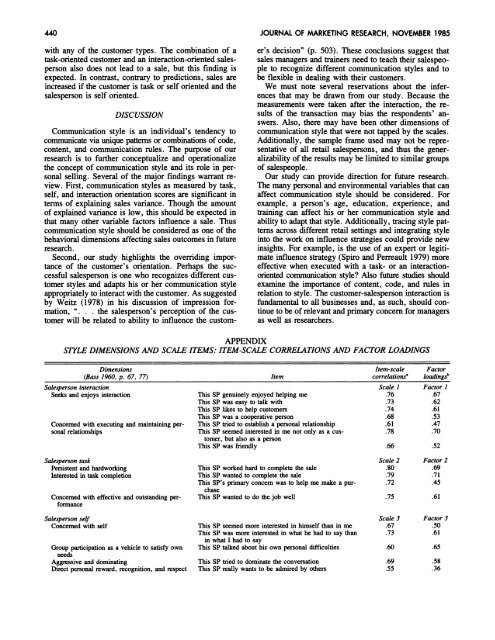Communication Style in the Salesperson-Customer Dyad
Communication Style in the Salesperson-Customer Dyad
Communication Style in the Salesperson-Customer Dyad
You also want an ePaper? Increase the reach of your titles
YUMPU automatically turns print PDFs into web optimized ePapers that Google loves.
440<br />
with any of <strong>the</strong> customer types. The comb<strong>in</strong>ation of a<br />
task-oriented customer and an <strong>in</strong>teraction-oriented salesperson<br />
also does not lead to a sale, but this f<strong>in</strong>d<strong>in</strong>g is<br />
expected. In contrast, contrary to predictions, sales are<br />
<strong>in</strong>creased if <strong>the</strong> customer is task or self oriented and <strong>the</strong><br />
salesperson is self oriented.<br />
DISCUSSION<br />
<strong>Communication</strong> style is an <strong>in</strong>dividual's tendency to<br />
communicate via unique patterns or comb<strong>in</strong>ations of code,<br />
content, and communication rules. The purpose of our<br />
research is to fur<strong>the</strong>r conceptualize and operationalize<br />
<strong>the</strong> concept of communication style and its role <strong>in</strong> personal<br />
sell<strong>in</strong>g. Several of <strong>the</strong> major f<strong>in</strong>d<strong>in</strong>gs warrant review.<br />
First, communication styles as measured by task,<br />
self, and <strong>in</strong>teraction orientation scores are significant <strong>in</strong><br />
terms of expla<strong>in</strong><strong>in</strong>g sales variance. Though <strong>the</strong> amount<br />
of expla<strong>in</strong>ed variance is low, this should be expected <strong>in</strong><br />
that many o<strong>the</strong>r variable factors <strong>in</strong>fluence a sale. Thus<br />
communication style should be considered as one of <strong>the</strong><br />
behavioral dimensions affect<strong>in</strong>g sales outcomes <strong>in</strong> future<br />
research.<br />
Second, our study highlights <strong>the</strong> overrid<strong>in</strong>g importance<br />
of <strong>the</strong> customer's orientation. Perhaps <strong>the</strong> successful<br />
salesperson is one who recognizes different customer<br />
styles and adapts his or her communication style<br />
appropriately to <strong>in</strong>teract with <strong>the</strong> customer. As suggested<br />
by Weitz (1978) <strong>in</strong> his discussion of impression formation,<br />
". . . <strong>the</strong> salesperson's perception of <strong>the</strong> customer<br />
will be related to ability to <strong>in</strong>fluence <strong>the</strong> custom-<br />
JOURNAL OF MARKETING RESEARCH, NOVEMBER 1985<br />
er's decision" (p. 503). These conclusions suggest that<br />
sales managers and tra<strong>in</strong>ers need to teach <strong>the</strong>ir salespeople<br />
to recognize different communication styles and to<br />
be flexible <strong>in</strong> deal<strong>in</strong>g with <strong>the</strong>ir customers.<br />
We must note several reservations about <strong>the</strong> <strong>in</strong>ferences<br />
that may be drawn from our study. Because <strong>the</strong><br />
measurements were taken after <strong>the</strong> <strong>in</strong>teraction, <strong>the</strong> results<br />
of <strong>the</strong> transaction may bias <strong>the</strong> respondents' answers.<br />
Also, <strong>the</strong>re may have been o<strong>the</strong>r dimensions of<br />
communication style that were not tapped by <strong>the</strong> scales.<br />
Additionally, <strong>the</strong> sample frame used may not be representative<br />
of all retail salespersons, and thus <strong>the</strong> generalizability<br />
of <strong>the</strong> results may be limited to similar groups<br />
of salespeople.<br />
Our study can provide direction for future research.<br />
The many personal and environmental variables that can<br />
affect communication style should be considered. For<br />
example, a person's age, education, experience, and<br />
tra<strong>in</strong><strong>in</strong>g can affect his or her communication style and<br />
ability to adapt that style. Additionally, trac<strong>in</strong>g style patterns<br />
across different retail sett<strong>in</strong>gs and <strong>in</strong>tegrat<strong>in</strong>g style<br />
<strong>in</strong>to <strong>the</strong> work on <strong>in</strong>fluence strategies could provide new<br />
<strong>in</strong>sights. For example, is <strong>the</strong> use of an expert or legitimate<br />
<strong>in</strong>fluence strategy (Spiro and Perreault 1979) more<br />
effective when executed with a task- or an <strong>in</strong>teractionoriented<br />
communication style? Also future studies should<br />
exam<strong>in</strong>e <strong>the</strong> importance of content, code, and rules <strong>in</strong><br />
relation to style. The customer-salesperson <strong>in</strong>teraction is<br />
fundamental to all bus<strong>in</strong>esses and, as such, should cont<strong>in</strong>ue<br />
to be of relevant and primary concern for managers<br />
as well as researchers.<br />
APPENDIX<br />
STYLE DIMENSIONS AND SCALE ITEMS: ITEM-SCALE CORRELATIONS AND FACTOR LOADINGS<br />
Dimensions<br />
(Bass 1960, p. 67, 77)<br />
<strong>Salesperson</strong> <strong>in</strong>teraction<br />
Seeks and enjoys <strong>in</strong>teraction<br />
Concerned with execut<strong>in</strong>g and ma<strong>in</strong>ta<strong>in</strong><strong>in</strong>g personal<br />
relationships<br />
<strong>Salesperson</strong> task<br />
Persistent and hardwork<strong>in</strong>g<br />
Interested <strong>in</strong> task completion<br />
Concerned with effective and outstand<strong>in</strong>g performance<br />
<strong>Salesperson</strong> self<br />
Concerned with self<br />
Group participation as a vehicle to satisfy own<br />
needs<br />
Aggressive and dom<strong>in</strong>at<strong>in</strong>g<br />
Direct personal reward, recognition, and respect<br />
Item<br />
This SP genu<strong>in</strong>ely enjoyed help<strong>in</strong>g me<br />
This SP was easy to talk with<br />
This SP likes to help customers<br />
This SP was a cooperative person<br />
This SP tried to establish a personal relationship<br />
This SP seemed <strong>in</strong>terested <strong>in</strong> me not only as a customer,<br />
but also as a person<br />
This SP was friendly<br />
This SP worked hard to complete <strong>the</strong> sale<br />
This SP wanted to complete <strong>the</strong> sale<br />
This SP's primary concern was to help me make a purchase<br />
This SP wanted to do <strong>the</strong> job well<br />
This SP seemed more <strong>in</strong>terested <strong>in</strong> himself than <strong>in</strong> me<br />
This SP was more <strong>in</strong>terested <strong>in</strong> what he had to say than<br />
<strong>in</strong> what I had to say<br />
This SP talked about his own personal difficulties<br />
This SP tried to dom<strong>in</strong>ate <strong>the</strong> conversation<br />
This SP really wants to be admired by o<strong>the</strong>rs<br />
Item-scale<br />
correlations'<br />
Scale 1<br />
.76<br />
.73<br />
.74<br />
.68<br />
.61<br />
.78<br />
.66<br />
Scale 2<br />
.80<br />
.79<br />
.72<br />
.75<br />
Scale 3<br />
.67<br />
.73<br />
.60<br />
.69<br />
.55<br />
Factor<br />
load<strong>in</strong>gsb<br />
Factor 1<br />
.67<br />
.62<br />
.61<br />
.53<br />
.47<br />
.70<br />
.52<br />
Factor 2<br />
.69<br />
.71<br />
.45<br />
.61<br />
Factor 3<br />
.50<br />
.61<br />
.65<br />
.58<br />
.36

















